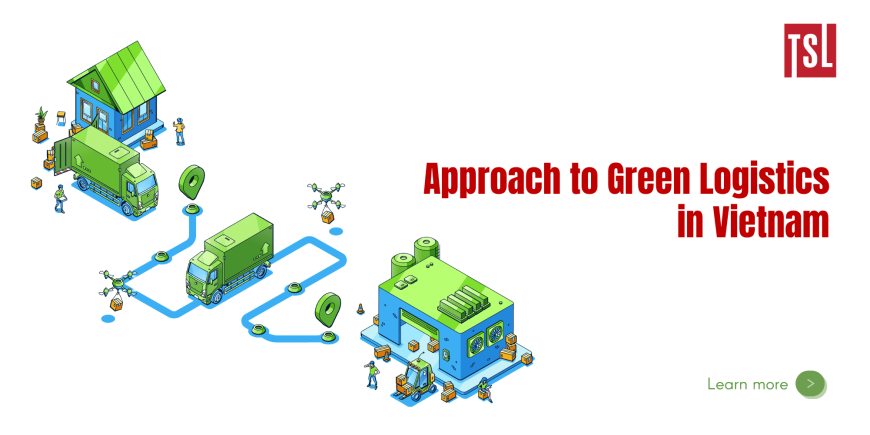Approach to Green Logistics in Vietnam
In Vietnam, green logistics activities are often seen as aiming at sustainable, friendly and environmentally friendly goals, minimizing negative impacts on the environment.
The concept of green logistics
The term “green logistics” or similar terms such as “sustainable logistics”, “sustainable green logistics”,… was first mentioned in the 1980s. Since then, many organizations and researchers have come up with different concepts of green logistics from different approaches.
In Vietnam, the concept of green logistics is still relatively new, so there is no unified and clear understanding. For the time being, there is a general way of thinking, which is logistics activities towards sustainable, friendly and environmentally friendly goals, minimizing negative impacts on the environment.
Green logistics emphasizes efforts and measures to minimize the negative impacts of logistics activities, thereby achieving a sustainable balance between economic, social and environmental goals (Sbihi & Eglese, 2010). Green logistics governs all three economic, social and environmental goals at the same time. These three goals are not mutually exclusive, but on the contrary reinforce each other. All efforts of green logistics are focused on contributing and ensuring sustainable development.
Content of green logistics development
Greening transport operations
Transportation is a logistics activity that has a great impact on the environment. There are two main factors of transport that affect the environment, including: the transport network system and the operation of the means of transport. Transport vehicles use a lot of fuel and emit harmful emissions into the environment. In particular, road vehicles have the most impact on the environment, reflected in emissions, noise and traffic congestion. Moreover, roads, airports, and ports are being built more and more which are major sources of pollution.
Upgrading the quality of the transport infrastructure system, converting from road transport to waterways and railways; Using environmentally friendly or low-carbon means of transport and operating the transport system optimally are important solutions to greening transportation.
Greening warehouse operations
The design and construction of the warehouse directly affects the energy usage of the warehouse. Warehouse design and construction not only requires ensuring safe storage of goods such as maintaining good humidity, anti-corrosion, waterproofing, anti-deformation, anti-evaporation, no leakage, …. but also to meet environmental standards. Warehouses with eco-friendly features such as using solar energy, natural light, suitable space, thick walls and floors or allowing on-site recycling will save energy, reduce noise and emissions to the environment. In addition, choosing to use environmentally friendly warehouse equipment and organizing warehouse operations optimally also reduces negative impacts on the environment. Good warehouse space planning not only helps to make optimal use of warehouse space, but also cuts down on movement in the warehouse. This forces businesses to choose the green design of warehouses to not only achieve economic efficiency but also increase the greenness in their logistics activities.
Greening packaging operations
Packaging is an important process for all products before they go to market. There are usually three types of packaging as primary packaging, secondary packaging, and shipping packaging. The main packaging contains the product. The size, shape, and material of the packaging have an impact on warehouse and shipping costs. Better product packaging with reused materials and optimally patterned pallets will result in significant cost savings through reduced material usage, increased warehouse space utilization and vehicle capacity, reducing the amount of packaging that needs to be handled.
Inappropriate packaging can lead to product damage during transportation and waste packaging, increasing the amount of waste released into the environment. As a result, innovative packaging technology will help minimize product loss during transit, while reducing the impact on the environment.
Greening the information system
A perfect information system can increase the level of logistics greening by providing real-time information and precisely and optimally control logistics activities such as packaging, storage, transportation, processing, distribution, loading and unloading, inventory handling… In order to comply with economic as well as environmental requirements, to facilitate the implementation of logistics services associated with environmental responsibility.
In addition, the digitization of data not only improves operational efficiency, increases labor productivity, and is convenient for information retrieval and data management, but also minimizes printing and reduces harm to the environment. In particular, the information link network between businesses and specialized agencies will reduce administrative procedures, save time as well as limit movement, contributing to minimizing adverse impacts on the environment.
Reverse logistics development
Green logistics development is indispensable to reverse logistics development, including two main activities: product recovery and reuse and waste treatment. Reverse logistics is the process by which businesses recover products returned by customers, products in need of warranty, maintenance or end-of-use products and packaging from the end consumer; make use of recycled materials, waste products and by-products in the production process; Collecting scraps from packing and transporting materials. Therefore, reverse logistics activities will contribute to environmental protection and bring many benefits to the sustainable development of enterprises.
Waste management is an important content for environmental protection and resource conservation. For example, when a warehouse generates a large amount of packaging waste or when products are expired or damaged, they become waste. At that time, how to treat waste so as not to affect the environment is extremely important.
*Source: vlr.vn







